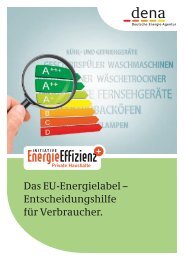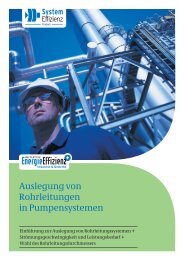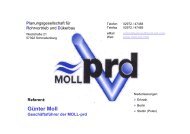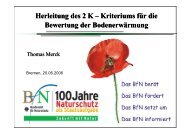biogaspartner – a joint initiative.
biogaspartner – a joint initiative.
biogaspartner – a joint initiative.
You also want an ePaper? Increase the reach of your titles
YUMPU automatically turns print PDFs into web optimized ePapers that Google loves.
Value.Chain.of.Biomethane.<br />
Criteria PSA PWS Genosorb MEA DEA<br />
Adsorption process physical physical chemical chemical<br />
Pre-cleaning necessary? Yes No No Yes Yes<br />
Required pressure (bar) 4 <strong>–</strong>7 4 <strong>–</strong>7 4 <strong>–</strong>7 depressurised depressurised<br />
Methane loss 3<strong>–</strong>10 % 1<strong>–</strong>2 % 1<strong>–</strong>4 % < 0.1 % < 0.1 %<br />
Methane content of the gas product > 96 % > 97 % > 96 % > 99 % > 99 %<br />
Required power consumption [kWh/Nm 3 ] 0.25 < 0.25 0.25<strong>–</strong>0.33 < 0.15 < 0.15<br />
Required temperature range [°C] No No 55 <strong>–</strong>80 160 160<br />
Range of controllability as percentages of total load +/<strong>–</strong> 10<strong>–</strong>15 % 50<strong>–</strong>100 % 50<strong>–</strong>100 % 50<strong>–</strong>100 % 50<strong>–</strong>100 %<br />
Processes already underway > 20 > 20 3 3 1<br />
Table: Parameters of different upgrade technologies. Source: Fraunhofer Umsicht (2009).<br />
of the relevant legal provisions and may only deviate within the<br />
range of these quality standards. such standards are realised<br />
using technologies for reconditioning gas. Because a non-negligible<br />
quantity of energy is necessary for gas compression, the<br />
energy balance and the economic feasibility of the compression<br />
and feed-in process must be reviewed on a case-by-case basis.<br />
Accessory.gas./.exchange.gas.<br />
With regard to feeding biomethane into the natural gas grid, it<br />
is necessary to distinguish between exchange gas and accessory<br />
gas. The difference lies in the quality of the gases. an exchange<br />
gas has the same qualitative standards as conventional natural<br />
gas and can be exchanged in the grid as such. accessory gas possesses<br />
a composition that is not equivalent to that of the natural<br />
gas, and can therefore only be mixed into the grid beneath a<br />
certain threshold.<br />
Quality.standards.<br />
regulations distinguish between low-quality natural gas<br />
(“natural Gas L”) and high-quality natural gas (“natural Gas H”).<br />
natural Gas H possesses a higher methane content, and is used<br />
mainly in the GUs federal states and extracted principally in the<br />
north sea.<br />
natural Gas L contains roughly 89 percent flammable gases<br />
(primarily methane, but also small amounts of ethane, propane,<br />
butane, and pentane), while natural Gas H contains about<br />
97 percent flammable gases (the same as those listed for natural<br />
Gas L).<br />
The types of natural gas available in Germany vary with geog-<br />
raphy. similarly, the degree to which biomethane is upgraded<br />
depends on the region of its origin.<br />
4.6.Sales.and.trade.<br />
The transport and sales of the injected biomethane is usually<br />
coordinated by a biogas or natural gas trading company. To<br />
transfer biogas from its production site to its end customer,<br />
36 B I o G a s P a r T n E r <strong>–</strong> a j o I n T I n I T I a T I v E<br />
these trading companies enter various business and contractual<br />
relationships with different partners. The following overview<br />
gives an idea of the biomethane sales dynamics in Germany.<br />
Biogas Accounting Grid Contract.<br />
In order to transport the injected biomethane via the gas grid,<br />
the trading company (also called “transport client”) is required<br />
to close a biogas accounting grid contract with the accounting<br />
grid operator. The grid operator balances the account of the<br />
biomethane amounts fed-in and out of the grid in an accounting<br />
grid and settles surplus and shortage quantities with the<br />
transport client.<br />
Grid Entry Contract.<br />
In order to be allocated to an accounting grid, the biogas supplier<br />
enters a contract with the Entry Grid operator. In this Grid<br />
Entry Contract, the parties agree on the quality criteria for the<br />
injected gas.<br />
Grid Exit Contract.<br />
The final customer enters into a grid exit contract with the exit<br />
grid operator settling the gas withdrawal at the physical gas<br />
exit point. The costs for the grid transport are the same as in<br />
natural gas transport transactions and are covered by the final<br />
customer together with grid access fees regardless of the feed-in<br />
location.<br />
Biomethane sales and trade in Germany differs from classic<br />
natural gas trade regarding the necessary proof of origins. The<br />
amounts of biomethane fed into the natural gas network must<br />
be documented along the value chain regarding the attributes<br />
required by law (“produced from renewable primary sources,<br />
for example). These attributes mostly derive from the legal and<br />
political conditions set in the renewable Energy sources act<br />
(EEG) and the renewable Energies Heat act (EEWärmeG).<br />
next to transport logistics and accounting matters, the trad-<br />
ing company also coordinates a gas portfolio. The company<br />
buys biogas quantities from various producers and delivers<br />
it to different (end) customers. also, the trading company is









